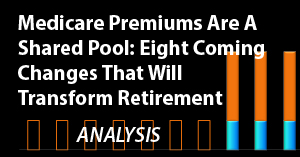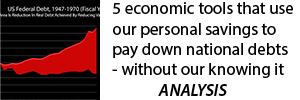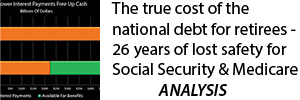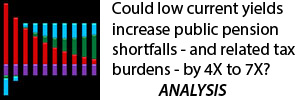Bubbly Assets & Bumbling Surgeons
By Daniel R. Amerman, CFA
TweetLet's say that you are going into surgery, you are worried, and you seek reassurance from the surgeon about what has happened in previous operations of this type. Obviously, what you want to hear about is the hundreds of times his team has done this procedure before, and the great results.
Instead, your surgeon says:
"We've done this twice before, and the patient has died both times. I'm still not sure how to do this, but I am hoping this time will work out better."
Would such an answer change your feelings about the surgery?
A real world example of that profoundly uncomfortable scenario can be found not in medicine, but in the financial world today. As we will explore in this analysis:
1) The Federal Reserve knew years ago that its zero interest rate policies were likely to inflate an asset bubble that would draw in many millions of investors.
2) The Fed also knew that it has never successfully surgically "deflated" an asset bubble before, but there have instead been market crashes and recessions each time the bubbles popped.
3) The Fed helped inflate the asset bubble anyway, because it didn't know what else to do. And it is raising interest rates again despite its poor record in the past, because it doesn't know what else to do in the attempt to return to "normality" for the economy and the markets.
Now, this does not mean that a bad outcome for the "procedure" is predetermined for this time around. The situation is of course different, as it always is.
The issue here is one of confidence. Are you fully confident in a surgeon who has never successfully completed a complicated procedure before? Should you be fully confident of a central bank in unchartered waters, attempting something very difficult which it has never successfully done before?
This analysis is part of a series of related analyses, an overview of the rest of the series is linked here.
The Current Situation Is No Surprise
For those who believe that the stock market is in asset bubble, there really shouldn't be any major surprise here. As I have been writing about for some years now, the side effect of creating an asset bubble was the known and fully anticipated flaw in the attempt to reboot the economy through near zero interest rates.
A particularly relevant analysis is "Does Economic Stagnation Create Dangerous Financial Bubbles?", which I sent to subscribers in September of 2014 (full article linked here). Those were very different days than today, but to understand why we are in the situation we are currently in - and the risks we face - it is necessary to better understand the path that brought us here.
For clarity, I will use strings of asterisks to separate the 2014 and 2018 analyses. The first excerpts from the 2014 analysis begin below.
****************************
Is a low growth economy with persistent unemployment issues surprisingly likely to lead to soaring securities prices and unstable financial bubbles?
Could very low interest rates and an aging population combine to create rapidly rising markets that are dangerously prone to sudden collapse?
Those questions may sound a bit counterintuitive, as it would seem to make sense that a weak economy should naturally lead to weak markets and falling prices, whereas it's a strong and healthy economy that should create rapidly rising market prices.
However, as explored by some prominent global economists in the new e-book, "Secular Stagnation: Facts, Causes and Cures", edited by Coen Teulings and Richard Baldwin, the creation of financial bubbles may indeed be the quite likely and expected result of current government policies around the world for dealing with stagnant economies and persistent unemployment. Indeed, the term "rational bubbles" is used to explain the rational reasons why weak economic times are particularly likely to create irrational prices that foster financial instability.
...(section removed)...
That is, what concerns these economists is that this environment of sustained very low interest rates combined with few good investment opportunities can be expected to foster the creation of financial bubbles and financial instability.
So that in the short term – and possibly even lasting for years – enormous paper wealth is created as a direct result of secular stagnation, until the bubble finally pops (as they always eventually do) at which time enormous economic and financial damage is inflicted on both investors as well as the financial system.
The danger is described by Lawrence Summers (Treasury Secretary in the Clinton administration, and former Director of the National Economic Council in the Obama administration) on pages 32-33 of the book.
"Low nominal and real interest rates undermine financial stability in various ways. They increase risk-taking as investors reach for yield, promote irresponsible lending as coupon obligations become very low and easy to meet, and make Ponzi financial structures more attractive as interest rates look low relative to expected growth rates. So it is possible that even if interest rates are not constrained by the zero lower
bound, efforts to lower them to the point where cyclical performance is satisfactory will give rise to financial stability problems. Something of this kind was surely at work during the 2003–2007 period."
**************************
OK, back to 2018 for a moment. Readers will likely recall my recent analysis (linked here), "The ABCs Of Popping A Third Asset Bubble". What Larry Summers is describing is A, B and D - how using very low interest rates to escape recession (A) creates bubbles (B) that will induce future financial instability (D). He is also agreeing that is what happened in 2003-2007.
What was well understand by leading economists around the world - including the economists of the Fed - is that what they were doing would likely create bubbles and future financial instability, but they didn't know what else to do.
The next section returns to the excerpts from the 2014 analysis.
****************************
Teulings and Baldwin considered the issue of "bubbles and low interest rates" to be one of the key new challenges created by secular stagnation (SecStag), and they devoted the entire third section of their introduction to the matter. The following quotations are from pages 13 and 14.
"Beyond ZLB issues, which have been the main concern in the SecStag discussion to date, low real rates can produce bubbles and foster financial instability – as Summers argues forcefully in his chapter. When the real rate, r, falls to values close to the economy’s growth rate, g, asset prices start to explode in a ‘rational’ way (as pointed out by Tirole 1985)."
"Bubbles are an alternative way for society to deal with excess saving when fiscal policy does not take up the challenge. Buying bubbly assets with the intention of selling them at a later date is an alternative route of saving for future consumption. When nobody wants to invest because r is below g, and hence buys bubbly assets, the price of these assets goes up, yielding windfall profits to their sellers who are therefore able to increase their consumption. This additional consumption restores the balance between supply and demand for loanable funds on the capital market."
"A greater supply of savings is one of the Wicksellian forces pushing the real interest rate down. Hence, ageing societies might run a greater risk of bubbles popping up."
****************************
Returning to 2018, the importance of the above quote from 2014 cannot be stressed enough. The leading macroeconomists of the world knew exactly what they were discussing - and so did the macroeconomists at the Fed.
They knew that they would likely be creating a "rational" asset bubble, it had been part of the academic literature since at least 1985.
They knew full well that by creating a pervasive environment of very low interest rates that they would be effectively impoverishing a generation of retirees who were dependent on interest earnings for their lifestyles - and would be creating a desperate appetite for yield among both retirees and retirement investors.
They knew that if the expected bubble appeared, in the process of inflating it would create desirable yields that would be drawing in retirees and retirement savings like moths to a flame.
They did this all knowing that they had no method for surgically deflating an asset bubble, and that there was instead a good chance that what Summers dryly referred to as "financial stability problems" would be the end result. (Which is the same thing I refer to as part D from the A-B-C-D movie plot line, i.e. a plunging market and severe recession).
Some might call that evil, but my interpretation is that that was not their intent. Economic growth was broken at the time. As economists they knew that every aspect of our current financial and investment system is built on unending economic growth - without it, everything breaks. So they were willing to sacrifice anybody and anything in the attempt to get economic growth back.
Now an interesting but unfortunate aspect of this has always been that the people whose savings are being sacrificed can be expected to feel really good about the process of being sacrificed - to absolutely love it in fact - right up until Summer's "financial stability problems" occur (if they do).
The next section returns to my 2014 analysis.
****************************
As the population ages, their economic productivity is likely to be falling, even as their consumption which drives future economic growth is also likely to be falling. Simultaneously, they have the largest amounts to invest in their latter years before retirement and in early retirement that they have ever had.
So productivity and consumption each fall while investable funds are peaking, thereby exacerbating the problem of a large supply of money seeking homes in what is otherwise a low yield environment.
And what happens as a result is that we get upward price movement in a given asset category.
As the prices climb upwards, this starts to produce a level of yields that are simply not available anywhere else. These attractive yields bring in new investors, which increases the prices, which then increases the yields while reinforcing the pattern, which in turn brings in the next round of money.
This pattern of rising prices drawing in money which fuels further rising prices – until rational valuations have been left far behind – is one of the oldest and most reliable stories in the history of finance and markets.
What is different this time around is the ready supply of cheap money, in combination with the lack of fundamental alternatives for investment, along with a large pool of older investors who are desperate for yield alternatives and are seeing attractive yields being created. While it may seem counterintuitive at first, these factors are all accelerants and in combination become the perfect recipe for creating a financial bubble.
...(section removed)...
A Potential Nightmare Scenario For Retirement Investors
Once we leave the dry and impersonal language of economics behind and consider the very personal implications for us all, what is being described in the Secular Stagnation e-book is a potential nightmare scenario for society as a whole, and for older investors in particular.
As a quite deliberate matter of government policy and as covered in my previous article, savers likely face years of negative returns (when adjusted for inflation), because the prevailing view among economists is that forcing negative returns on savers is the best way to fight economic stagnation. So, if we stick with conventional investment strategies, there are virtually no yields available unless one either ups the risk or participates in the bubbles that are likely to be created as a direct side-effect of those same stagnation-fighting policies. And if one participates in a bubble then one takes one's chances, because that's the thing about bubbles – you never know when they're going to pop.
****************************
(Back to 2018.)
Today's investment challenges exist inside a broad framework that has been developing over a period of many years - for those who have been watching. For long-time readers, I hope that my analyses have been helpful to you over the years, in terms of understanding that framework.
Oh, there is continual randomness and variability, chaos and unexpected developments. The future could never be known with certainty and a lot of what is happening today in the world could not have been predicted a year ago, let alone three or four years ago.
But that an asset bubble or asset bubbles would follow an extended period of historically low interest rates is not random or a surprise - it is what decades of economic theory says should happen. It is the expected result.
The acute vulnerability of retirees and retirement investors is also expected, as reviewed herein. They should have the greatest need, the yields created by the inflating of the "rational" asset bubble should have been irresistible for many of them (despite the popping of the previous two bubbles in the last 20 years), and they should be feeling really good about it right now.
So what happens next?
I don't think anyone knows for sure. The future is always uncertain, and there are many things that are indeed different this time around.
But when it comes to assessing what is reasonable and what we should feel comfortable with - the analogy with the surgeon that we began this analysis with is worth keeping in mind, as is the A-B-C-D movie plot line linked here.
There is no proven central banking path for how to surgically and safely deflate an asset bubble that was created as the expected byproduct of using very low interest rates to stimulate higher economic growth rates - if that is indeed our current situation. And the last two times it was attempted - the patient "died on the table", so to speak.
It might work this time, nothing says it can't. But for someone who is making decisions that could determine financial security for years and decades to come - there is a case for keeping in mind the "surgical" track record of the Federal Reserve when it comes to this particular procedure, as an important consideration.

















